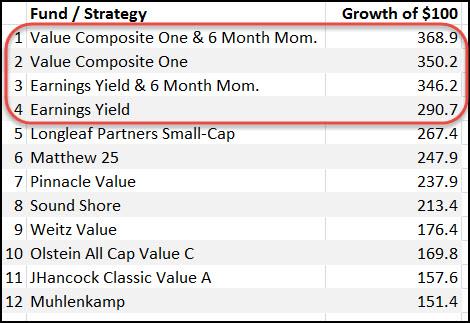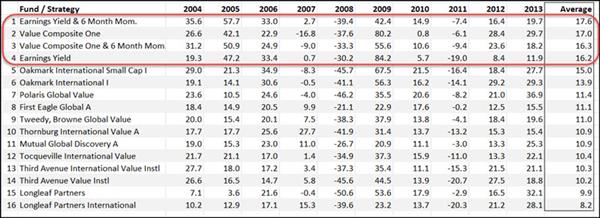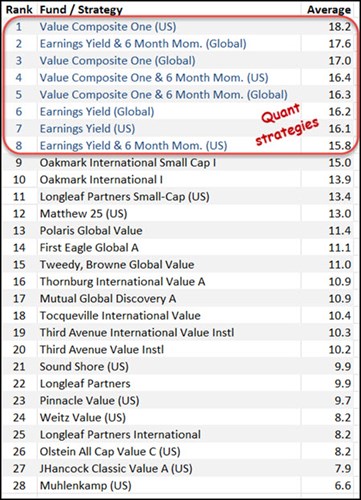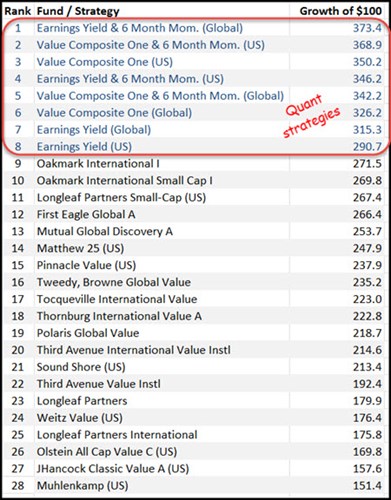Can a simple quantitative value strategy (using just one simple ratio) outperform the worlds best value investment funds?
Value investing works
If you have studied investing for any length of time I'm sure you are also convinced that, over long periods of time, value investing is the best investment strategy. Even thought it sometimes underperforms the market for long periods of time.
What to compare value investing returns to?
Value investing can be implemented in a number of ways. For example some value investors look at price to book ratios, others to price to earnings others use free cash flow.
With all these different ways you can apply value investing how do you know if you (or your value fund manager) is doing as well as you could, even if you are outperforming the market?
An easy test
The best way to test this is to compare the top value investment funds to a few simple quantitative value investing strategies.
You can easily find a lot of really good quantitative value investing strategies in the best quantitative investing books. What Works on Wall Street by James O'Shaughnessy and Quantitative Value: A Practitioner's Guide to Automating Intelligent Investment and Eliminating Behavioral Errors by Westley Gray and Tobias Carlisle.
Based on these great books and our research from the research paper I wrote with a friend called Quantitative Value Investing In Europe: What Works for Achieving Alpha.
I chose a few, easy to implement, qualitative value investing strategies.
How we tested it
From the Morningstar.com website I got the ten-year returns (2004 to 2013) of the best US based value investing funds that invest only in the USA as well as globally.
Back-test universe
For the quantitative value investing strategies I looked for companies with a market value of more than $1 billion and with median liquidity of € 0.25 million per day.
For the US only funds we only selecting companies with a primary listing in the USA.
For global value investment funds we looked at companies in Western Europe, the UK, Switzerland and Scandinavia.
Return adjustments -1.5%
From the return generated by the qualitative value investment strategies we deducted 1% for dealing costs for buying and selling (this is conservative as most investment funds can deal buy and sell investments for a lot less, most likely under 0.5%).
We also made provision for bid ask spreads deducting 0.5% from the yearly returns.
Survivorship bias eliminated
When implementing the quantitative value strategies we included companies in the investment universe that have gone bankrupt or re-organised in the past 10 years.
This is done to ensure that the strategies do not only select from companies that have survived the past 10 years.
Should a company have gone bankrupt or delisted returns were calculated using the last stock exchange price of the company before it was delisted.
How the strategy was implemented
Each year we selected 50 companies for each strategy that comply with the above guidelines.
After one year all the investments were sold and this amount (including dividends) was re-invested in a further 50 quantitative value investment ideas.
The quantitative value investing strategies
The quantitative value investment strategies we tested were:
1. Cheapest Earnings Yield (earnings before interest and taxes (EBIT) / Enterprise value)
2. Cheapest Earnings Yield combined with best six months share price momentum
3. Best ranked Value Composite One* value companies
4. Best ranked Value Composite One* value companies combined with best six months share price momentum
* You can read more about the Value Composite One in the Glossary and this article: This combined valuation ranking gives you higher returns - Value Composite One
These are all investment strategies you can easily implement with the Quant Investing stock screener.
Click here to get the best quant value strategies working for you
Value funds vs Quantitative value
So how did the value funds perform against the quantitative value strategies?
Investing in US companies only
All funds and quantitative value strategies sorted by average returns
4.8% better
As you can see the best quantitative value strategy outperformed the best US value fund by an average of 4.8% per year for 10 years.
Even the worse performing quantitative value strategy on average did 2.4% (per year for 10 years) better than the best performing US value fund.
Call me conservative but this is substantial!
All funds and quantitative value strategies sorted by 10 year compound returns
If you invested $100 in each of the funds and and the quantitative value strategies this is the amount you would have had at the end of the 10 years.

100% more after 10 years
The difference in total return over 10 years between the best fund and best quantitative value strategy was also substantial.
If you followed the best quantitative strategy at the end of 10 years you would have had $368.9 in your pocket (for every $100 at the start), 100% ($100) more compared to the $267.4 you would have if you invested in the best performing value fund.
Investing in companies worldwide
All funds and quantitative value strategies sorted by average return
On average 2.6% better
As you can see on average the best global quantitative value strategy outperformed the best value fund by 2.6% per year for 10 years.
Even the worse performing quantitative value strategy on average did 1.2% (per year for 10 years) better than the best performing value fund.
All funds and quantitative value strategies sorted by compound returns

Also 100% more after 10 years
The difference in total return over 10 years between the best fund and best quantitative value strategy was also substantial.
If you followed the best global quantitative strategy at the end of 10 years you would have had $373.4 in your pocket (for every $100 at the start), more than 100% ($100) more compared to the $271.5 you would have had if you invested in the best performing value fund.
Surprising results
The results are really surprising.
Even if you have already spent a lot of time studying quantitative value investment strategies I am sure they also surprised you.
One simple ratio beats best fund
As you can see all the qualitative value strategies tested outperformed the value investment funds, both for the US a as well as the funds that invest globally.
Even if you invested using a simple one ratio quantitative value investment strategy, earnings yield (EBIT to Enterprise value), you would have out-performed the best value investing funds in the business.
What if you put all the quantitative strategies and funds (US and global) together you may be thinking?
Click here to get the best quant value strategies working for you
All together
If you put the returns on the US and global strategies together (not surprisingly) ALL the quantitative value strategies did better than the value funds.
Ten year average returns

3.2% better
As you can see the best global quantitative value strategy outperformed the best value fund by an average 3.2% per year for 10 years.
Even the worse performing quantitative value strategy on average did 0.8% (per year for 10 years) better than the best performing value fund.
Cumulative returns over ten years

Also 100% more after 10 years
The same as the other cumulative returns above the difference in total return over 10 years between the best fund and best quantitative value strategy was substantial.
If you followed the best quantitative strategy at the end of 10 years you would have had $373.4 in your pocket (for every $100 at the start), more than 100% ($100) more compared to the $271.5 you would have had if you invested in the best performing value fund.
Why isn’t everyone doing it?
If these quantitative strategies work so well why aren’t more investors following them you may be thinking?
The reason is that it looks a lot easier to do than it is.
As James Montier writes in in the research paper Painting By Numbers: An Ode To Quant
“The most likely answer is overconfidence.
We all think that we know better than simple models.
The key to the quant model's performance is that it has a known error rate while our error rates are unknown.
The most common response to these findings is to argue that surely a fund manager should be able to use quant as an input, with the flexibility to override the model when required.
However, as mentioned above, the evidence suggests that quant models tend to act as a ceiling rather than a floor for our behaviour.
Additionally there is plenty of evidence to suggest that we tend to overweight our own opinions and experiences against statistical evidence.”
Other reasons are:
Miss the largest winners
It is easy to avoid the biggest winners because these companies are in the quantitative model for a good reason, they are undervalued and you are most likely to find a lot of news on exactly how bad these companies are.
It’s not easy to buy a company if all the news you can find on it is negative.
It may not always work
In spite of substantial past market beating results investors usually abandon a quantitative strategy when it starts to underperform the market, thinking the strategy is broken.
And this even if the strategy has a substantial back tested history and real world performance of market outperformance.
Have you tried it in the real world?
I'm sure you'll also be wondering if we have tried any of the above mentioned strategies in the real world.
We have and it worked so well that I started a newsletter called Quant Value.
Study the full track record
You can find the full track record of the newsletter here: Quant Value Newsletter Track Record
PS If you have found this article of interest take a look at our stock screener and newsletter products
PPS It is so easy to put things off why not sign up right now before it slips your mind
Click here to get the best quant value strategies working for you


